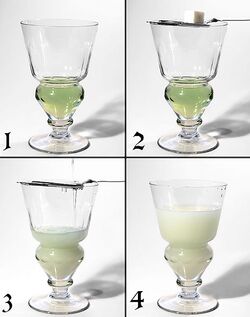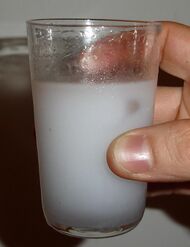Biology:Ouzo effect

Observation and explanation

The ouzo effect occurs when a strongly hydrophobic essential oil such as trans-anethole is dissolved in a water-miscible solvent, such as ethanol, and the concentration of ethanol is lowered by addition of small amounts of water.
Oil-in-water emulsions are not normally stable. Oil droplets coalesce until complete phase separation is achieved at macroscopic levels. Addition of a small amount of surfactant or the application of high shear rates (strong stirring) can stabilize the oil droplets.
In a water-rich ouzo mixture the droplet coalescence is dramatically slowed without mechanical agitation, dispersing agents, or surfactants. It forms a stable homogeneous fluid dispersion by liquid–liquid nucleation.[1] The size of the droplets when measured by small-angle neutron scattering was found to be on the order of a micron.[2]
Using dynamic light scattering, Sitnikova et al.[3] showed that the droplets of oil in the emulsion grow by Ostwald ripening, and that droplets do not coalesce. The Ostwald ripening rate is observed to diminish with increasing ethanol concentrations until the droplets stabilize in size with an average diameter of 3microns.
Based on thermodynamic considerations of the multi-component mixture, the emulsion derives its stability from trapping between the binodal and spinodal curves in the phase diagram.[2] However, the microscopic mechanisms responsible for the observed slowing of Ostwald ripening rates at increasing ethanol concentrations appear not fully understood.
Applications
File:Louche effect grapefruit-cello.webm Emulsions have many commercial uses. A large range of prepared food products, detergents, and body-care products take the form of emulsions that are required to be stable over a long period of time. The ouzo effect is seen as a potential mechanism for generating surfactant-free emulsions without the need for high-shear stabilisation techniques that are costly in large-scale production processes. The creation of a variety of dispersions such as pseudolatexes, silicone emulsions, and biodegradable polymeric nanocapsules, have been synthesized using the ouzo effect, though as stated previously, the exact mechanism of this effect remains unclear.[4] Nanoparticles formed using the ouzo effect are thought to be kinetically stabilized as opposed to thermodynamically stabilized micelles formed using a surfactant due to the fast solidification of the polymer during the preparation process.[5]
See also
- Interface and colloid science
- Miniemulsion
- Anise-flavored liqueurs on the list of liqueurs
- Spinodal
References
- ↑ Vitale, Stephen A.; Joseph L. Katz (May 2003). "Liquid Droplet Dispersions Formed by Homogeneous Liquid-Liquid Nucleation: The Ouzo Effect". Langmuir (American Chemical Society) 19 (10): 4105–4110. doi:10.1021/la026842o.
- ↑ 2.0 2.1 Grillo, Isabelle (September 2003). "Small-angle neutron scattering study of a world-wide known emulsion: Le Pastis". Colloids and Surfaces A 225 (1–3): 153–160. doi:10.1016/S0927-7757(03)00331-5. http://www.crmcn.univ-mrs.fr/pics/linked-files/LePastis_IGrillo.pdf. Retrieved 2007-01-29.
- ↑ Sitnikova, Natalia L.; Rudolf Sprik; Gerard Wegdam; Erika Eiser (2005). "Spontaneously Formed trans-Anethol/Water/Alcohol Emulsions: Mechanism of Formation and Stability". Langmuir 21 (16): 7083–7089. doi:10.1021/la046816l. PMID 16042427. http://www.science.uva.nl/~sprik/personal/pdf/05/la046816l.pdf. Retrieved 2007-01-29.
- ↑ Ganachaud, François; Joseph L. Katz (2005). "Nanoparticles and Nanocapsules Created Using the Ouzo Effect: Spontaneous Emulsification as an Alternative to Ultrasonic and High-Shear Devices". ChemPhysChem 6 (2): 209–216. doi:10.1002/cphc.200400527. PMID 15751338.
- ↑ Almoustafa, Hassan; Mohammed A. Alshawsh; Zamri Chik (2017). "Technical aspects of preparing PEG-PLGA nanoparticles as carrier for chemotherapeutic agents by nanoprecipitation method". International Journal of Pharmaceutics 533 (1): 275–284. doi:10.1016/j.ijpharm.2017.09.054. PMID 28943210. https://www.sciencedirect.com/science/article/abs/pii/S0378517317309201.
External links
 |

